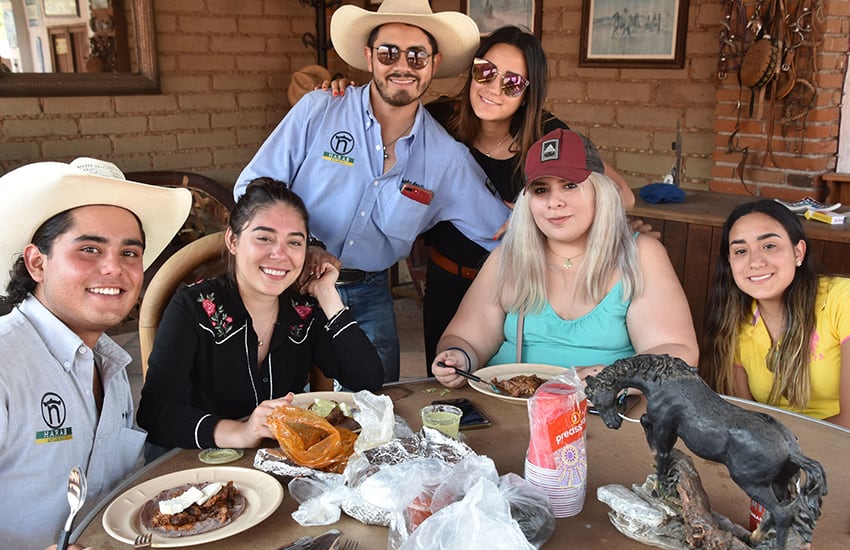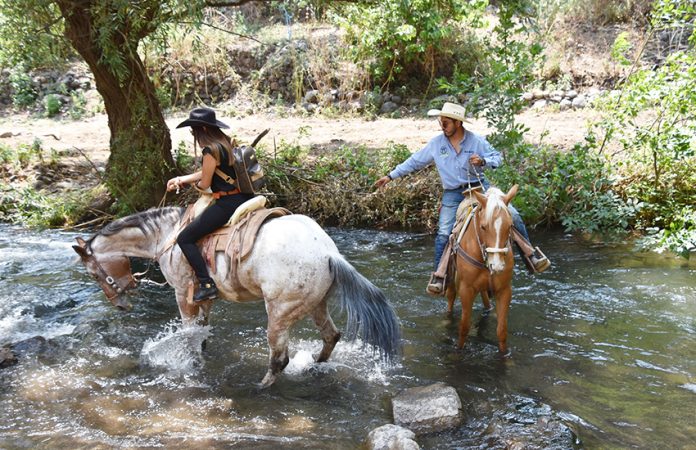I swore I was done with horses after riding one for 16 long, exhausting hours during the pilgrimage to Amatlán in 2019.
I went on that pilgrimage as part of my project to document a year’s worth of pilgrimages, ceremonies and other events in San Gregorio Atlapulco, a neighborhood in the borough of Xochimilco in Mexico City. It was supposed to take a group of eight of us around seven hours to reach Amatlán — a significant enough trek — but we got lost four times in the mountains and lost again in a couple of small pueblos as thunderclouds threatened. The unenjoyable ride took 24 hours, and when I finally dismounted, every part of my body ached.
I know the cliché about getting back on the horse, but the thought of actually doing it brought back some rather unpleasant memories.
Then I met Ignacio Aguilar Gómez, who owns Haras Atlixco, which advertises “Ecotourism by Horse.” Despite my misgivings, I decided to, well, get back on the horse when he invited me to take a ride. I’m glad I did.
Haras Atlixco is located in Valle de Atlixco, about a 20-minute drive from the center of Atlixco. José Ignacio Aguilar Fernández, Aguilar’s son and the site’s manager, served as my tour guide.

The property is a 150-acre hacienda, built by the family in the 1800s. Part of the original construction, which originally had cattle and a dairy, has been kept, including the main house, the dairy, horse sheds and a small chapel.
“My father started the ecotourism site about 10 years ago,” said Aguilar. Three or four acres on the property are set aside specifically for ecotourism. “Ecotourism is where there are no large cities. It is in the rural areas, to be in contact with nature … It is something different from what people are used to.”
They offer three ecotourism packets. The shortest, at 500 pesos , lasts an hour. The two-hour ride costs 600 and the longest, 2 1/4 hours, is 700 pesos (about US $35).
“It is a ride with a guide who takes care of the people for the entire time,” Aguilar said. “The maximum number is 10 people, the minimum is two, but if one person shows up, we will take them but charge a little extra.” It’s best to make a reservation at least a day in advance.
Anyone not familiar with riding horses is given basic instructions that last around 20 minutes. If a person wants to ride but is still wary, “We can use a rope to guide the horse,” he said.
Before getting on our horses, he gave me a tour of the hacienda.
The dairy still is a working one, and the sheds house 50 or 60 horses (they also board them). They also have some huge greenhouses.
“We grow tomatoes that we sell to the United States,” he explained. “We also have campgrounds that people can rent and a place that if someone wants to have a large fiesta, we can do that. If it is just a couple who want to come and enjoy the hacienda, we can do that. People can come and just have a picnic.”
Our final stop was the chapel. Given my previous experience with riding a horse, I thought about saying a quick little prayer there, but the door was locked; I wasn’t sure if that was a bad sign.
I must have looked a little concerned because he assured me I’d be all right. “We make sure the horses are ready to ride safely and without any problems,” he said.
We headed out on the two-hour ride with four other people, including Jorge Gutiérrez, a friend of Aguilar’s who sometimes works as a guide.
We rode through rows of greenhouses, the plants inside heavy with tomatoes, and when we left the property, we crossed a two-lane road — with Aguilar and Gutiérrez making sure everyone got across safely — and through a collection of small houses. Then the land opened up.

Hills rose in the distance and, initially, everything was brown. But then we entered a lush, green meadow where a stream ran swiftly on one side. Butterflies flitted among the flowers and small plots of corn. We passed two small waterfalls and trees with huge, beautiful, exposed roots. Along the way, Aguilar and Gutiérrez often burst into song, clearly happy to be on the trail again. They had surprisingly good voices.
Gutiérrez stuck close to me as I (mostly) brought up the rear. I must have still looked a little apprehensive because he told me, “We have never had a problem, no injuries.” I silently vowed to make sure I wasn’t the first and am happy to say that I wasn’t.
On the return trip, we could see in the distance what most people believe is an unexcavated pyramid with a small chapel on top. It’s located at the edge of Atlixco.
We made it back to the hacienda after almost 2 1/2 hours in the saddle. I admit to feeling a little sore, but a delicious meal — Aguilar said it’s the best barbacoa around — and a cold beer took care of that.
Currently, there’s no restaurant on site, and if a group wants food it’s ordered from nearby restaurants. There are plans to build a restaurant and some cabañas.
Like virtually everything else, Haras Atlixco has been affected by Covid.
“At the beginning of the pandemic, we had strict restrictions,” Aguilar said. “People had to wear masks. Now, things have loosened a little, and when we are outside riding, it is not necessary to use a mask. With things closed [due to the pandemic], people looked for something different. They looked for alternatives, and many of them looked for this.”
I took a taxi to the site, and the driver used GPS, which is usually accurate, but we ended up on a narrow dirt road, at the end of which was a locked gate. The GPS indicated a seven-minute walk to the hacienda, so I got out and started walking until a young man told me it was private property. He vaguely pointed in the direction where he said Haras Atlixco was located, saying it was a 15-minute walk.
I returned to the main road. and when I saw two workers, I asked them if they knew where Haras Atlixco was.
“Señor,” I was told, ”I know this area well. There is no such place. There is nothing here.”
There always seems to be an adventure within an adventure for me. Fortunately, I was able to call Aguilar, who showed up on an ATV.
If you’re considering a visit, it’s probably best to call for clear directions.
Haras Atlixco is located in Prados el León, 74360 Atlixco, Puebla. The phone number is 222-199-4328. Or you can contact them via their Facebook page.
Joseph Sorrentino, a writer, photographer and author of the book San Gregorio Atlapulco: Cosmvisiones and of Stinky Island Tales: Some Stories from an Italian-American Childhood, is a regular contributor to Mexico News Daily. More examples of his photographs and links to other articles may be found at www.sorrentinophotography.com He currently lives in Chipilo, Puebla.
